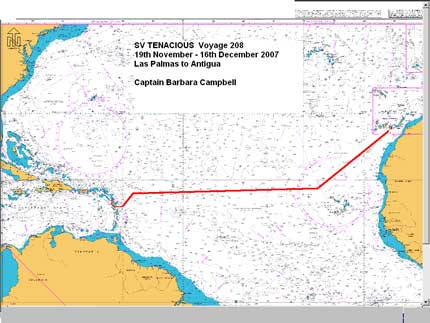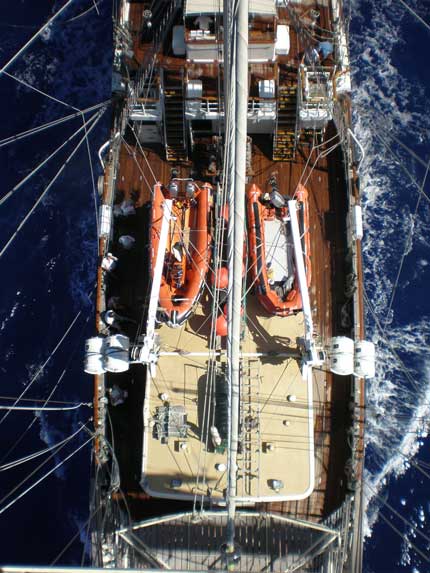|
Tenacious Brings the
Handicapped World Together
By Matthew Brown
It was with great
anticipation that I walked this sunny November
day of 2007, along the marina filled with 1500
boats, searching for the vessel that would take
me from these Canary Islands off the Coast of
Africa across the Atlantic in the trade wind
route to the Caribbean. I paused from time to
time, seeking out the Barque silhouette with
three masts, the forward two having yardarms.
Her profile should have been easy to spot among
the sloops and ketches readying themselves for
their own Atlantic crossing. Owned, built, and
operated by the Jubilee Sailing Trust (JST) in
Southampton, England the Tenacious, at
215 feet, is one of two Barques JST owns
dedicated to sailing for people of all
abilities.
I finally spotted her frame
in the distance. As my excitement grows, so do a
few questions and doubts.
 |
| Teamwork helps. |
Arriving on board, I am
greeted by several crewmembers and soon realize
that one of my questions has been answered: of
the 43 passengers on board, I will be the only
American. Tenacious’ Irish ship doctor,
a lone Dane, and I join 40 others from England
and Scotland.
This is my fourth crossing of
the Atlantic, my first since suffering a stroke
in April of 2005. I am used to boats under 50
feet in length and not accustomed to the
comforts of a larger sailing vessel like
Tenacious. My bunk rests in a spacious room
with nine others that boasts two showers
available at all times - even with hot water.
The galley has ample space, the freezer is huge,
and the mess hall below has large tables and a
dumbwaiter that bring our plated meals to us. On
deck, the maze of ropes aloft in the rigging is
dizzying. Supporting the yardarms and sails
above, we spend our first few days bracing and
setting.
 |
| |
After a briefing by Captain
Barbara Campbell, we are walked through the
safety and routines of the ship by the first and
second mates and the chief engineer, a man also
in charge of the ‘courage bar’, the local
watering hole in the lower mess, open one-half
hour during lunch and dinner and four hours
every evening. The lower mess was soon to become
the meeting place for meals and a place for us
to share our stories of yesterday and today,
along with our dreams of tomorrow.
Part of our training includes
going aloft into the rigging, each of us donning
a full body harness with two tethers connecting
us to the ship. The view and experience produce
more than a few gasps and sighs as we venture up
the masts and out onto the yardarms to practice
harbor stows of the sail, a practice in securing
the sails to avoid flapping so the ship looks
her best as she pulls into port. To my
amazement, going aloft is accessible to everyone
- whether they climb the ratlines slowly or have
their wheelchair hoisted skyward.
Tenacious has 13
permanent crew in addition to the 30 voyage
crewpersons, three of whom are confined to
wheelchairs.
 |
| Tall ships are always fun when you can
get up high and play in the rigging. |
Among us is also a blind
crewmember; several type one diabetics, and
folks with various other disabilities. Our
voyage crew is organized into four watches, or
groups. It is with these seven people that I’ll
share watch and eating times, daily information,
cleaning duties, trivia nights, and other
activities during our crossing.
Each watch has a trained
volunteer leader, and mine is named Dave. He is
wheelchair bound, and although he’s spent time
on several sailing trips, this is his first
‘trans At’ as the Brits say. He has been
involved with the JST since its founding and was
prominent in every step of the Tenacious’
construction. His knowledge of her every inch
proves to be welcome and interesting
conversation on even the longest
four-to-eight-am shifts.
After topping the main engines’ diesel tanks and
generators and shopping for last minute
provisions, we are ready for our 3000-mile
journey to the French Caribbean Island of
Guadalupe. With the wind coming over the stern
of the boat at dock, Captain Barbara uses the
engines to nudge us clear of the wharf as the
crew sets the upper and lower courses. Sailing
out of the Las Palmas harbor, it appears to
onlookers that we do this sort of thing
everyday.
We began around 26° north
latitude and sail a southwesterly course in
varying wind speeds and direc
 |
| Tenacious overview. |
tions to 23° north
latitude to catch the trade winds, which blow
east to west each November following hurricane
season. By sailing down to these lower
latitudes, we are able to give ourselves a
buffer zone that would protect us from any storm
driven winds that might occur above 25° north.
Now at sea, we are on our
watch schedule that will remain intact for the
duration of the voyage: four hours on and 12
hours off, with each of us sharing galley duty
every seven days, time spent preparing, serving,
and cleaning up after each meal. While on watch
we take turns at the helm of the boat, sail
handling and checking to see that our course is
clear.
Our watch consists of varying
sailing abilities - from people like Bill, who
has been confined to a wheelchair his entire
life with Spinea Bifida, on his first sailing
trip, to Peter, a 72-year-old retired physical
therapist who went blind in his early 50s but
continued his practice until his 60s, who is on
his second crossing onboard Tenacious.
The boat and her crew bring
out the best in everyone as she blurs ability
lines. Everyone participates in all sailing
duties and activities day after day, around the
clock, it is truly inspiring to see folks walk
or roll their chairs in seas of up to 15 feet
with the boat healed over in stiff winds or
below deck serving dinner and washing dishes. We
are encouraged to push ourselves to the point
not only to where we feel comfortable, but just
beyond what we think we might be able to do.
Our crossing takes us
seventeen days at an average speed of 6.7 knots,
as we’re under sail alone for seventy two
percent of the time, thanks to the steady trade
winds. While everyone enjoyed the sun rises, sun
sets, and dolphins and whales swimming around
Tenacious’ hull, we are all happy to
reach our destination and have six days to sail
around the islands before our trip ends in
Antigua.
 |
| |
Now home…it was a wonderful
experience to see people of all abilities
working toward the common goal of a fun and safe
journey out into the ocean - a place where very
few people, especially those with disabilities,
venture to take on Mother Nature and all she has
to offer. Sailing can be inclusive - it’s just a
matter of finding your ship to sail away on a
afternoon, week-end or month, or, as the Brits
would say, “Which ever is your cup of tea.”
Matthew Brown lives in Grand Marais, MN. He
works at North House’s Folk School and Superior
Marine Training. A slide show of the Atlantic
Crossing trip is available. Contact Matthew at
218-387-1741.
TOP
|